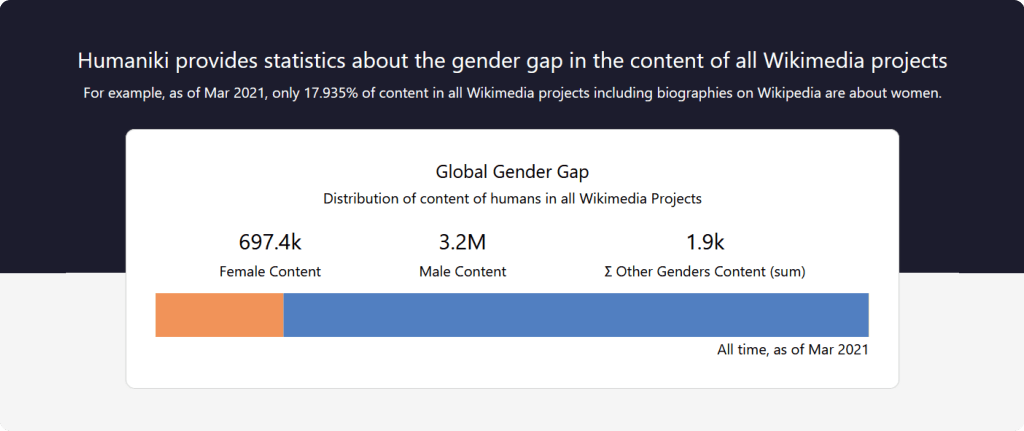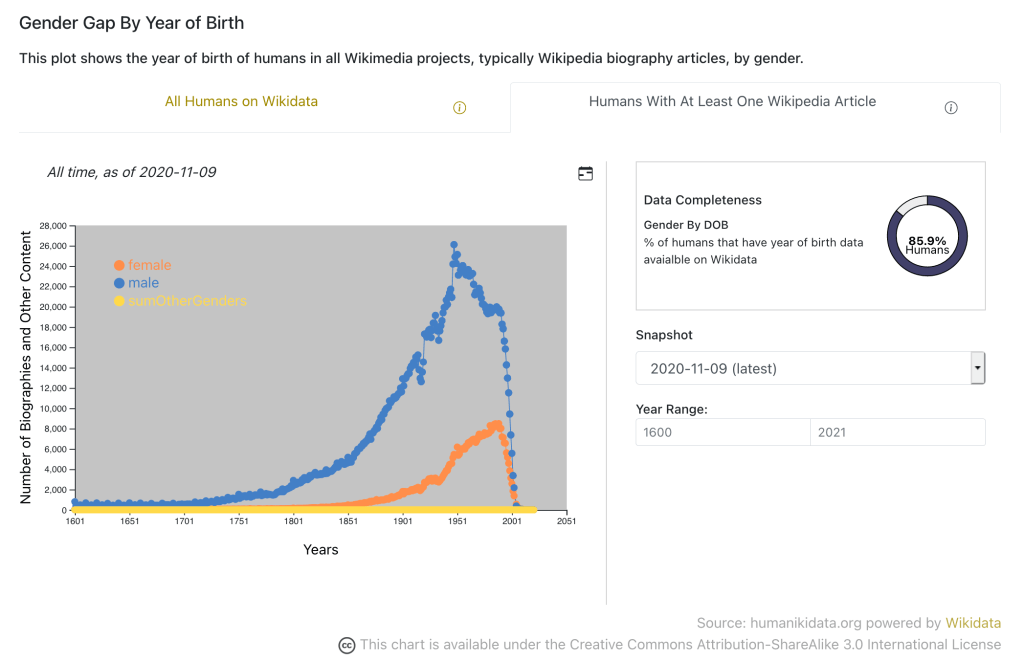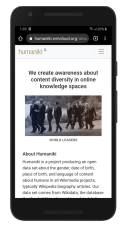
We’re pleased to announce to the public the first release of Humaniki, a dashboard tool to help editors who aim to improve gender representation. This launch brings the core functionality of searchable statistics that evaluate gendered-content diversity on all Wikimedia projects, typically Wikipedia biography articles. It is available starting today at humanikidata.org – however we are still not finished developing the project, and appreciate your feedback.
What’s new?
In this first release we focused on getting our central technology robust.
1. Core Denelezh and WHGI features with improvements
You can check the biography gender gap for Wikipedia Projects, Year of Birth, Citizenship, and combinations thereof, both now and historically, just as you used to with WHGI and Denelezh. We have improved the exploration experience by:
- Adding toggles to switch between the “all wikidata” and “items with one wikimedia page” populations
- Multi-dimensional tables now have aggregated indexes, indexes have text-search filters, and columns are sort-able.
- All 23 genders that exist on Wikidata are being tracked and can be added to the table view.
2. Providing Interactive and Customizable Visualizations

Humaniki revamps three popular visualizations from WHGI and makes them interactive: gender by country, by wikimedia project, and date of birth. They all have added interactivity.
- Gender by Country
- now implements community-requested feature of selectively highlight countries.
- now allows adjustment of the highlighted gender.
- Gender by Wikimedia Project
- This visualization used to be very messy but the inclusion of our add-datapoint point features clears this picture up.
- Gender by Date of Birth
- can now interactively apply date ranges.
- All visualizations
- can now show historical data using the “Snapshot” dropdown.
- can toggle “all wikidata” vs “items with one wikimedia page” data with the population toggler.
3. Provide screenshot ready visualizations with the metadata information listed in the view
One of the highest use cases our tools in the past was to provide publicity about some of the gaps in Wikimedia projects. We took this usage seriously and invested time into the presentation of the site, making sure that the site was easily “screenshotable”. Note the population, range filters, title, and data completeness statistics are composed well. The new data completeness section shows what percentage of Wikidata items have the accompanying property. For instance in the visualization below, “year of birth” (Wikidata’s P569) is present for 85.9% of human’s, with at least one Wikipedia article.

4. New Architecture


One of our core aims with Humaniki was to merge the previous somewhat overlapping tools of Denelezh and WHGI, and eventually replace them both. That has resulted in some less visible improvements in the architecture.
- Abstracted data model will enable allows us to easily track more statistics about humans in the future beyond gender.
- API-based allowing more use cases beyond our dashboard (see API docs).
- Modern technologies in use such as react-js, so that richer interactions could be built, and we have a nice mobile view now too.
All these separation of concerns in the architecture we believe will also make it easier for new developers to get involved.
What’s coming later, in the beta release.
As mentioned, this does not represent the final state of Humaniki, but an initial checkpoint in order to get community feedback. Items still on our todo list are:
1. Occupation data
Denelezh has long been collecting data about the gender gap by occupation, and even understands the Wikidata occupation “tree”, making it able to categorize both Ice skaters and Footballers as ‘athletes’. That feature will come to Humaniki soon (see T270046)
2. Backfill data
Between Denelezh and WHGI our team has most of the statistics we’ve been collecting dating back to 2014. We plan to import this historical data into Humaniki soon. (In the mean you can still access this data at Denelezh, but it isn’t being updated any more).
3. Evolution view
Along with that backfilled data it can be useful to visualize and explore trends in variables longitudinally (see T275332). Coming soon.
4. Internationalization
With our abstracted data model and move to modern web frameworks, we are well positioned to offer our site in multiple languages (see T274079). If you want to be part of translation efforts, please get in touch.
5. List view (Gender Campaigns Tool)
As well as providing statistics on the gender gap, our data and API can be the backbone of the proposed “Gender Campaigns Tool” that will allow for interactive list making and tracking (see T274085).
How can I contribute?
Reporting Bugs or Feature Requests
Our beta release is scheduled for August 2021, to see how we plan to get there, view our roadmap. Our Roadmap is comprised of elicited features from our user research and strategically prioritized. Of course we continually invite your feedback, use these links to add feature requests and report bugs.
Develop with us
We welcome the open source developer communities to take up any open feature requests that seem fit to their interests and help us build a diversity data tool that the community needs. Our data processing and backend stack is built on Wikidata-Toolkit (java), Sqlalchemy & Flask (python), backed by mysql 8. Our frontend tech stack is React & d3 (javascript). You can learn more about the stacks in our Contribution Guide, and the data model in our API documenation.
If you are interested in taking up this project as a part of Outreachy or Google Summer of Code paid internship programs, please reach out to us and we can make an attempt to support it.
– Sejal, Max, Eugenia and Envel of the Humaniki team.
Email us: info@humanikidata.org
Check us out on Twitter: @humanikiData

Can you help us translate this article?
In order for this article to reach as many people as possible we would like your help. Can you translate this article to get the message out?
Start translation